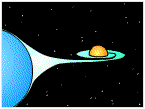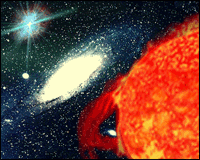General Theory Of Relativty
Created | Updated Nov 4, 2010
History
The history of general relativity dates back to 1915. Albert Einstein had a problem with Newtonian gravity. He had recently proved that nothing could exceed the speed of light, but in Newton's theory, gravity acts instantaneously, that is much faster than light.
So Einstein had to come up with a solution. What he did was imagine the 3 dimensions of direction and the 1 dimension of time.
This allowed him to create space-time. Space time was a kind of 4 dimensional fabric that heavy objects bend. The amount of bend is subject to mass and density.
This said that gravity was not instantaneous, Einstein calculated that it moved exactly at the speed of light.
Theory
The theory behind it all is that you can't move an object through space without having it also moved in time, so Einstein put his magnificent brain to work and thought that if he combined the two he would get results. His classical mechanics equation is as follows1.
Rab-1/2Rgab=ΚΤab
The Ricci curvature tensor (Rab)- is the tensor of curved space. Curved space is used to determine the 3 dimensions of direction and is formally called a Riemann Manifold. It basically suggests that everything is carved into a sphere. In short it is a geodesic.
The Metric tensor (Rgab)- This is used to measure straight, linear space. Or Euclidean space as it is formally called. It represents the 1 dimension of time as time is straight and linear.
The Energy Momentum tensor (kTab)- This tensor is used to describe the momentous action of the curves created by matter that interrupts the space time linearity. The relativistic constant (k) is equivalent to 8πG/c4
This states the curvature from Ricci (pi) and the linearity of metric (c- speed of light).
This stated that, the 3 dimensions of direction represented by the Ricci Curvature tensor, added onto The 1 dimension of time represented by the metric tensor is equivalent to the energy momentum tensor.
If the product was momentous, then that meant that 4 dimensional space was expanding. This also proved the expansion of the universe, this meant that if the universe was expanding. Energy and all it's attibutes were causing it. It is now known that dark energy propels the expansion of the universe.2
However there was a flaw. If the universe was expanding, then how come it didn't just collapse under it's own gravity? Einstein introduced a new type of relativity equation in his field equations (below). This meant that there had to be a mathematical constant to prevent this collapsing. It was named the cosmological constant. What Einstein hated most about his equation was that. So he discarded it. Little did he know that it was put back in after his death due to the arise of a new theory: Proportional expansion. This stated that the universe was expanding at the rate of the constant that was allowing it to do so.
Field Equations
The Einstein field equations are the more practical equations that apply in the field. This is called the field equations because the field is the electromagnetic world, and the interactions of gravitation are similar to those of electromagnetism in Scottish physicist James Clerk Maxwell's four equations of electromagnetism.
The translation of the classical one (above) into EFE is below.
Gμν+Λμν=(8πG/c4)Τμν
The Ricci curvature tensor + the cosmological constant (the constant that stops the universe crushing itself) multiplied by the metric tensor=The relativistic coefficient3 multiplied by the energy momentum tensor.The reason they are more like Maxwell's equations is because they are all kept with a coefficient, or constant. This is to stop the equations from running off to the infinite otherwise they would be wrong.
Visualisation
To viisualise the concept of Einsteinian gravity, we need to show the curvature of space-time. The visualisation is done by looking into space and seeing the profound effects of gravity. When we look at the sun, we can't see that it is a massive curve that is keeping it there.
If a sattelite were to observe a pair of binary stars in orbit of eachother it can't find their bendings of space-time. All it sees is something similar to fig 1.14.

To imagine space-time, imagine an invisible grid. As an object on them gets heavier the lines lengthen a loose curve is formed and goes downward. If we were to see the Earth normally it would look like a globe floating in space. But if we imagine the space-time curvature it looks like a ball on a tightly stretched elastic sheet.
Suggestions Made By Relativty
General Relativity is not just used for defining gravity. Oh no,it predicted something that makes any star look like a complete wimp when talking about curvature. Yeas, general relativity suggested that if space-time was warped enough, then a black hole would form. To vissualise a black hole, imagine a small point no bigger than a pea. Then imagine the mass of that pea was at least 25 times that of the sun! Then imagine how warped space-time would get if that little tyke fell on it. There would be a massive tube with an infinite gravitational pull. There would be a point of no return, the event horizon and anything orbiting it will be victim to massive speeds, sending them to millions of degrees celsius. They create the accretion disk.
This was why many were determined to look away. Even light would fall victim to a black hole. Many thought it was impossible, it was only untill there was direct evidence of their existence that we fully accepted relativty without further question. The laws of physics may break down there but it does exist.
So if they do exist then waht creates them? Well the answer is a star of at least 30 solar masses. When the star runs out of fuel, it supernovas. It explodes in a magnificent display that outshines galaxies. This implodes and crushes the core with all the mass down to the size of a pea. This is a new born black hole.
A black hole would look along the lines of fig1.2.

Gravitational Microlensing and Lensing
Gravitational microlensing is when an object's light such as that of a quasar (supermassiveblackhole) Is sent out in beams. The beams then make contact with a massive object like a galaxy. The galaxy bends the light and sends it the other way, shrinking the image of the quasar because of it's mass.
Gravitational lesing, is when a similar thing happens but the rays are bent so much that they deflect and make the object look bigger, though this is extremely rare, it does happen.
It is because of this that we get the Einstein cross. The Einstein cross is when the same object is repeated 4 times in a perfect cross due to strong lensing.
Attempts at a Unified Field Theory
A unified field theory is a theory of everything. General relativity looks good enough for it but, however well it describes the large world it does not describe the subatomic world of particles and strings.
There is a rival theory, that theory is called quantum mechanics, it is the opposite of relativity. It describes the small but not the big.
So we attempted to unify them for a theory of everything.
There were two different main theories.
- String and M Theory- This theory says that the universe is sealed in 11 dimensions, and is one of an infinite amount of different parralel universes. Strings include the graviton (gravity string) and calabi yau manifolds.
- Quantum Gravity- This is an attempt to try and explain gravity at the quantum level, it introduces new theories about calming of the space-time continuum at the subatomic level.
An Introduction to String Theory
String theory states that the quark is not the smallest form of matter. It states that there are strings for every specific purpose in the universe, such as gravitation (graviton string) or quantum laws.
It also introduces the idea of more dimensions. It suggests that there are 11 dimensions and the strings are sealed in the 10th or the 11th.
There are two types of strings. Open ended and the closed nded. The only closed ended one is the graviton. The rest are all open ended. Because the graviton is sealed, it needs to be in a higher dimension (as dimension= degrees of freedom, sealed string has less degrees of freedom in 10th dimension). This is why the graviton is responsible for gravitation in string theory. It is sealed in isolation in the 11th dimension. This gives it a profound effect on other strings. It's degrees of freedom make it vibrate in all directions in a way that sends influence to the other gravitons.
String theory also suggests the idea of paralel universes. It is the idea that membranes of the strings stretch out to create universes.
